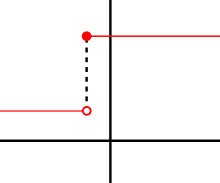Left and right derivative

In mathematics, the terms left derivative and right derivative are used to describe certain kinds of derivatives.
Derivatives arising from one-sided limits
The most common use is to describe the one-sided limit of a function defined on a subset of the real line,[1] (see semi-differentiability). Under this notation, the right derivative is defined as
and the left derivative as
If the left and right derivatives are equal, then they have the same value as the usual ("bidirectional") derivative. One can also define a symmetric derivative, which equals the arithmetic mean of the left and right derivatives (when they both exist), so the symmetric derivative may exist when the usual derivative does not.[2]
Application
If a real-valued, differentiable function f, defined on an interval I of the real line, has zero derivative everywhere, then it is constant, as an application of the mean value theorem shows. The assumption of differentiability can be weakened to continuity and one-sided differentiability of f. The version for right differentiable functions is given below, the version for left differentiable functions is analogous.
Theorem: Let f be a real-valued, continuous function, defined on an arbitrary interval I of the real line. If f is right differentiable at every point a ∈ I, which is not the supremum of the interval, and if this right derivative is always zero, then f is constant.
Proof: For a proof by contradiction, assume there exist a < b in I such that f(a) ≠ f(b). Then
Define c as the infimum of all those x in the interval (a,b] for which the difference quotient of f exceeds ε in absolute value, i.e.
Due to the continuity of f, it follows that c < b and |f(c) – f(a)| = ε(c – a). At c the right derivative of f is zero by assumption, hence there exists d in the interval (c,b] with |f(x) – f(c)| ≤ ε(x – c) for all x in (c,d]. Hence, by the triangle inequality,
for all x in [c,d], which contradicts the definition of c.
Differential operators acting to the left or the right
Another common use is to describe derivatives treated as binary operators in infix notation, in which the derivatives is to be applied either to the left or right operands. This is useful, for example, when defining generalizations of the Poisson bracket. For a pair of functions f and g, the left and right derivatives are respectively defined as
In bra–ket notation, the derivative operator can act on the right operand as the regular derivative or on the left as the negative derivative.[3]
See also
References
- ↑ Stewart, James (2012). Calculus: Early Transcendentals, 7th edition. Cengage learning. ISBN 978-0538497817.
- ↑ Peter R. Mercer (2014). More Calculus of a Single Variable. Springer. p. 173. ISBN 978-1-4939-1926-0.
- ↑ Dirac, Paul (1982) [1930]. The Principles of Quantum Mechanics. USA: Oxford University Press. ISBN 978-0198520115.